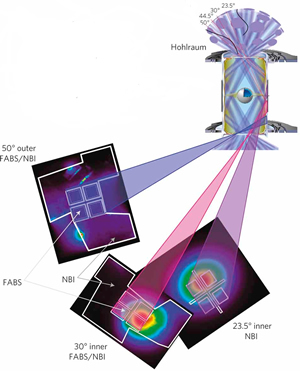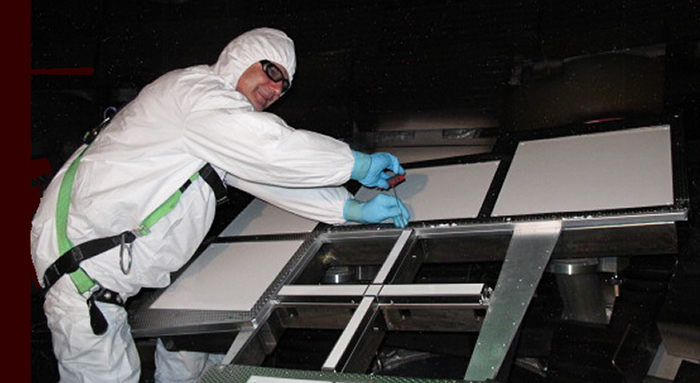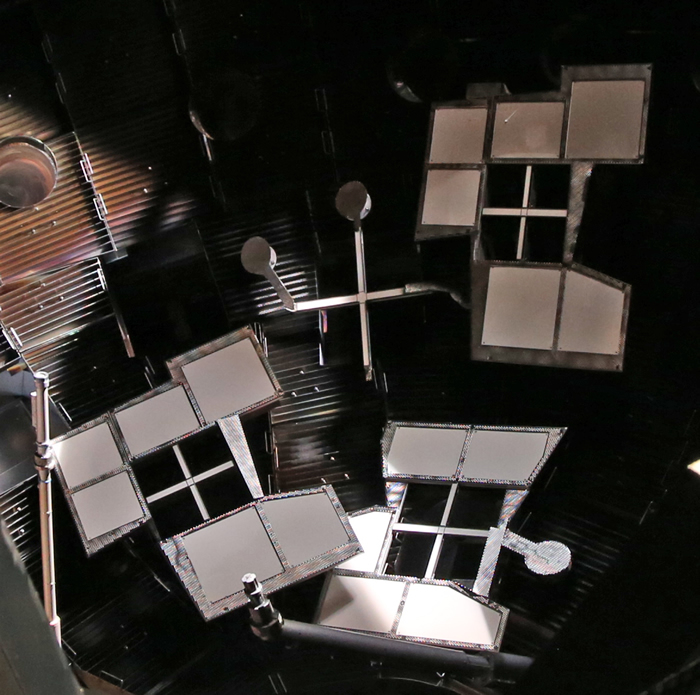Science & Technology - 2014
November
Vital NIF Diagnostic Upgraded
When the National Ignition Facility’s 192 high-power laser beams are fired, a series of complex events begins. To capture and measure the vast amount of data generated during experiments, NIF is now equipped with about 60 nuclear, optical, and x-ray diagnostics. One of these diagnostics, the Near Backscatter Imager (NBI), recently received an important upgrade.
 The optical backscatter system on NIF consists of a Full Aperture Backscatter Station (FABS) and a NBI instrument for one outer (50°) and one inner (30°) quad and a NBI detector at 23.5°. The images show the geometry of the instruments relative to the hohlraum and actual measurements of scattered light as well as interpolation/extrapolation to extend the measurements to missing scatter-plate regions.
The optical backscatter system on NIF consists of a Full Aperture Backscatter Station (FABS) and a NBI instrument for one outer (50°) and one inner (30°) quad and a NBI detector at 23.5°. The images show the geometry of the instruments relative to the hohlraum and actual measurements of scattered light as well as interpolation/extrapolation to extend the measurements to missing scatter-plate regions. Developed in the mid-2000s, the NBI is run during nearly every kind of experiment conducted at NIF and measures backscatter, which is the result of the interaction of incident laser light and plasma waves at a target.
Plasmas are composed of free ions and free electrons. Both the ions and electrons can have high amplitude waves. When the laser interacts with ion waves, the resultant scattered light is called Stimulated Brilluoin Scattering (SBS). This backscattered light is close to the incident light wavelength and returns back into the beamlines, where it can reach powers and energies sufficient to damage optics in the NIF laser system.
Electrons produce high frequency waves in a plasma. Light scattering from the electron plasma waves is called Stimulated Raman Scattering (SRS), a type of laser-plasma instability. In SRS, electron density fluctuations in the plasma cause the incident laser light to scatter resonantly. High levels of backscatter reduce the coupling of laser energy to the fusion target and constrain implosion symmetry and other design parameters (see an animation).
NBI provides the most accurate total SBS and SRS backscattered energy measurements on the NIF. The diagnostic does this by measuring the light backscattered outside the NIF beamlines onto diffuse Spectralon™ scatter plates surrounding the “quad” of four beamlines. Precisely calibrated images of the backscattered light on the scatter plates are used to determine the time-integrated spatial distribution and total energy of SBS and SRS independently. Additionally, fibers are used to create power-time histories and spectra of the backscattered light.
NBI scatter plates have been installed on NIF since 2009 and have degraded over time. During a planned upgrade, the two original scatter plates were replaced. In addition, two new devices were installed, allowing the backscatter to be measured on all four NIF beam cone angles once the imaging system upgrade is installed next summer. This system will provide a more complete picture of the backscatter from targets.
 Target Area Operations’ Mike Vacca installs new Near Backscatter Imager scatter plates inside the NIF Target Chamber.
Target Area Operations’ Mike Vacca installs new Near Backscatter Imager scatter plates inside the NIF Target Chamber. “The new system was also designed to be more operationally friendly—if maintenance is required it is easy to do,” said Robin Hibbard, lead NBI engineer. “The new design is modular, so if there is any failure a module can be replaced quickly.
“From a scientific perspective,” he said, “putting new hardware in allows for resetting the system calibration with the new material. It also allows inspection and measuring the old hardware and the calibration can be checked against experimental data.”
In addition to Hibbard as lead engineer, other contributors to NBI include Joe Ralph, lead scientist; Bob Chow, responsible system engineer; Mike Vitalich, mechanical designer; Jarom Nelson, calibration; and John Moody, group leader for hohlraums and optical diagnostics.
 The upgraded Near Backscatter Imager installed in the NIF Target Chamber.
The upgraded Near Backscatter Imager installed in the NIF Target Chamber. Adding Radiant Heating Capability to NASA’s Heat-Shield Research
NIF & Photon Science researchers are working with NASA Ames Research Center at Moffet Field, California on the development of technology to simulate re-entry effects on the heat shield for the Orion spacecraft, NASA’s next crewed spaceship. Orion is designed to carry astronauts beyond low Earth orbit to deep-space destinations such as an asteroid and eventually Mars.
The Orion heat shield will have to withstand re-entry temperatures that are too severe for existing reusable thermal protection systems, such as those used on the space shuttles. NASA’s development and characterization of a more robust shield requires that radiant heating capability be added to the Arc Jet Complex at NASA Ames, which develops thermal protection materials and systems in support of the Orion Program Office at NASA Johnson Space Center in Houston and the NASA Human Exploration and Operations Mission Directorate at NASA headquarters in Washington, DC.
 Technicians install a protective shell onto the Orion crew module for its first test flight this December. (Credit: NASA/Dimitri Gerondidakis)
Technicians install a protective shell onto the Orion crew module for its first test flight this December. (Credit: NASA/Dimitri Gerondidakis) NASA Ames currently owns two 50 kilowatt (kW) commercial fiber laser systems and needs to augment the optical power into the Arc Jet chamber by another 100 to 200 kW. The team at Ames recently approached LLNL to explore an option of using commercially available radiance-conditioned laser diode arrays for this task, similar to the diodes used in the Laboratory’s Diode-Pumped Alkali Laser (DPAL) and E-23/HAPLS laser projects. Their aim is to assess whether such systems can better meet the technical objectives for survival testing. If successful, such diode arrays would offer a dramatically lower-cost solution.
To perform these tests, LLNL is collaborating with Ames on diode array characterizations using an existing diode system developed for LLNL’s laser programs. These tests will allow NASA Ames to assess whether their optical output can meet in-chamber target illumination requirements, and thus inform their choice for a future system.
While the space shuttles traveled at 17,000 miles per hour, Orion will be re-entering Earth’s atmosphere at 20,000 miles per hour on its first flight test in December. The faster a spacecraft travels through the atmosphere, the more heat it generates. The hottest the space shuttle tiles got was about 2,300 degrees Fahrenheit; the Orion back shell could get as hot as 4,000 degrees. For more about Orion, see the NASA video:



